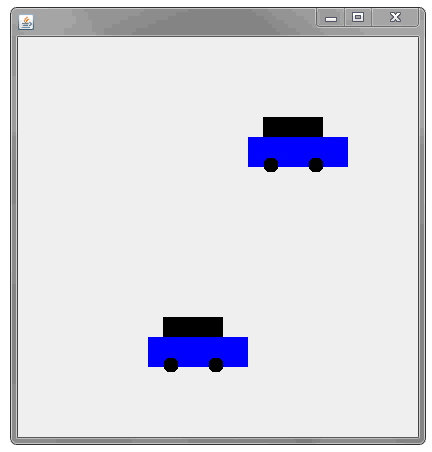ί░Ηίνγϊ╕ςύ╗Εϊ╗╢ύ╗αίΙ╢ίΙ░όκΗόη╢ϊ╕φ
όΙΣόφμίερί░ζϋψΧί░Ηίνγϊ╕ςό▒╜ϋ╜οίψ╣ϋ▒κύ╗αίΙ╢ίΙ░ίΡΝϊ╕Αϊ╕ςύςΩίΠμϊ╕ΛΎ╝Νϊ╜ΗύεΜϋ╡╖όζξίχΔϊ╗υόφμίερύδ╕ϊ║ΤϋοΗύδΨήΑΓ
ϋ┐βόαψόΙΣίερCarύ▒╗ϊ╕φώΘΞίΗβύγΕpaintComponentόΨ╣ό│Χ
public void paintComponent(Graphics g) {
Graphics2D g2 = (Graphics2D) g;
g2.setColor(wheelColor);
g2.fill(leftWheel);
g2.fill(rightWheel);
g2.setColor(bodyColor);
g2.fill(body);
g2.fill(cab);
}
ίερόΙΣύγΕViewerύ▒╗ϊ╕φΎ╝γ
JFrame f = new JFrame();
initializeFrame(f);
Car x = new Car(100, 100);
Car y = new Car(300, 300);
f.add(x);
f.add(y);
ϋβ╜ύΕ╢ίζΡόιΘϊ╝╝ϊ╣Οϊ╕ΞίΡΝΎ╝Νϊ╜ΗίΠςύ╗αίΙ╢ϊ║ΗόεΑίΡΟϊ╕Αϋ╛Ηϋ╜οήΑΓ
όεΚϊ╗Αϊ╣Ιί╗║ϋχχίΡΩΎ╝θόΕθϋ░λ
2 ϊ╕ςύφΦόκΙ:
ύφΦόκΙ 0 :(ί╛ΩίΙΗΎ╝γ12)
όΓρϋοΒίΒγύγΕόαψϊ╜┐ύΦρCarϊ╕ςίψ╣ϋ▒κύγΕόΧ░όΞχύ╗ΥόηΕΎ╝Νί╣╢ίερpaintComonentόΨ╣ό│Χϊ╕φί╛ςύΟψίχΔϊ╗υήΑΓίΔΠ
List<Car> cars = new ArrayList<>();
....
@Override
protected void paintComponent(Graphics g) {
super.paintComponent(g);
for (Car car : cars) {
car.drawCar(g);
}
}
drawCarόΨ╣ό│ΧόζξϋΘςόΓρύγΕCarύ▒╗
public class Car {
int x, y;
public Car(int x, int y) {
this.x = x;
this.y = y;
}
public void drawCar(Graphics g) {
g.setColor(Color.BLACK);
// do everything here as you would in a paintComponent method
}
}
όθξύεΜόδ┤ίνγύν║ϊ╛ΜhereίΤΝhereϊ╗ξίΠΛhereίΤΝhereϊ╗ξίΠΛhereίΤΝhereήΑΓ
<ί╝║>όδ┤όΨ░
ϋ┐βόαψϊ╕Αϊ╕ςύχΑίΞΧύγΕϊ╛ΜίφΡΎ╝Νϊ╜┐ύΦρϊ║Ηϊ╕Αϊ║δέΑεό│ΧόΜΚίΙσέΑζόΙΣόΟΑϋ╡╖ϊ║ΗίΛρϊ╜εΎ╝Νϊ╣θϊ╜┐ύΦρϊ║Ηϊ╕Αϊ║δίΛρύΦ╗Ύ╝Νϊ╜ΗόΙΣύγΕϊ╕Λϋ┐░ίθ║όευύΓ╣ύδ╕ίΡΝήΑΓ

import java.awt.Color;
import java.awt.Dimension;
import java.awt.Graphics;
import java.awt.event.ActionEvent;
import java.awt.event.ActionListener;
import java.util.ArrayList;
import java.util.List;
import javax.swing.JFrame;
import javax.swing.JPanel;
import javax.swing.SwingUtilities;
import javax.swing.Timer;
public class DrawCar extends JPanel{
private static final int D_W = 400;
private static final int D_H = 400;
List<Car> cars;
public DrawCar() {
cars = new ArrayList<>();
cars.add(new Car(100, 300));
cars.add(new Car(200, 100));
Timer timer = new Timer(50, new ActionListener(){
public void actionPerformed(ActionEvent e) {
for (Car car : cars) {
car.move();
repaint();
}
}
});
timer.start();
}
@Override
protected void paintComponent(Graphics g) {
super.paintComponent(g);
for (Car car : cars) {
car.drawCar(g);
}
}
@Override
public Dimension getPreferredSize() {
return new Dimension(D_W, D_H);
}
public class Car {
private static final int INCREMENT = 5;
int x, y;
public Car(int x, int y) {
this.x = x;
this.y = y;
}
public void drawCar(Graphics g) {
g.setColor(Color.BLUE);
g.fillRect(x, y, 100, 30);
g.setColor(Color.BLACK); // body
g.fillOval(x + 15, y + 20, 15, 15); // wheel
g.fillOval(x + 60, y + 20, 15, 15); // wheel
g.fillRect(x + 15, y - 20, 60, 20); // top
}
public void move() {
if (x == D_W) {
x = 0;
} else {
x += INCREMENT;
}
}
}
public static void main(String[] args) {
SwingUtilities.invokeLater(new Runnable() {
public void run() {
JFrame frame = new JFrame();
frame.add(new DrawCar());
frame.setDefaultCloseOperation(JFrame.EXIT_ON_CLOSE);
frame.pack();
frame.setLocationRelativeTo(null);
frame.setVisible(true);
}
});
}
}
ύφΦόκΙ 1 :(ί╛ΩίΙΗΎ╝γ5)
┬ι┬ιϊ╜Ηϊ╝╝ϊ╣Οϊ╗Ψϊ╗υϊ║Τύδ╕ϋοΗύδΨήΑΓ
JFrameύγΕώ╗αϋχνί╕Δί▒ΑύχκύΡΗίβρόαψBorderLayoutήΑΓίδιόφνΎ╝Νώ╗αϋχνόΔΖίΗ╡ϊ╕ΜΎ╝ΝόΓρί░ΗόΚΑόεΚύ╗Εϊ╗╢ό╖╗ίΛιίΙ░BorderLayoutύγΕCENTERήΑΓϊ╜ΗόαψΎ╝ΝόΓρίΠςϋΔ╜ίΡΣCENTERό╖╗ίΛιϊ╕Αϊ╕ςύ╗Εϊ╗╢Ύ╝ΝίδιόφνίΠςόα╛ύν║όεΑίΡΟϊ╕Αϊ╕ςCarήΑΓ
ί░Ηί╕Δί▒ΑύχκύΡΗίβρόδ┤όΦ╣ϊ╕║FlowLayoutϊ╗ξόθξύεΜί╖χί╝ΓήΑΓ
όΙΨϋΑΖΎ╝ΝύεΜϋ╡╖όζξϊ╜ιϋψΧίδ╛ίερώγΠόε║ϊ╜Ξύ╜χύ╗αίΙ╢ό▒╜ϋ╜οΎ╝Νίερϋ┐βύπΞόΔΖίΗ╡ϊ╕Μϊ╜ιί║Φϋψξϊ╜┐ύΦρέΑεnullέΑζί╕Δί▒ΑήΑΓύΕ╢ίΡΟΎ╝ΝόΓρί░Ηϋ┤θϋ┤μϋχ╛ύ╜χόψΠϊ╕ςό▒╜ϋ╜ού╗Εϊ╗╢ύγΕίνπί░Π/ϊ╜Ξύ╜χήΑΓ
- ίνγϊ╕ςύ╗Εϊ╗╢ύγΕSwingόΧ░όΞχύ╗Σίχγ
- ίερόκΗόη╢ϊ╕Λύ╗αίΙ╢ύθσί╜λ
- ίνγϊ╕ςύδ╕ϊ║Τϊ╛ζϋ╡ΨύγΕJComponentsΎ╝Νό▓κόεΚώΑΤί╜Τί╛ςύΟψ
- ίοΓϊ╜Χί░Ηίνγϊ╕ςJComponentsό╖╗ίΛιίΙ░JPanelΎ╝θ
- ί░Ηίνγϊ╕ςύ╗Εϊ╗╢ύ╗αίΙ╢ίΙ░όκΗόη╢ϊ╕φ
- ίερMouseEventϊ╕Λύ╗αίΙ╢ίΠψϋπΒύγΕJComponents
- ίερίνγϊ╕ςόκΗόη╢ϊ╕Λύ╗αίΙ╢ύθσί╜λ
- ϊ╕║ϊ╗Αϊ╣ΙJComponentsό▓κόεΚίΘ║ύΟ░ίερόκΗόη╢ϊ╕φΎ╝θ
- όψΠί╜Υί╕πίΙΗϋ╛ρύΟΘόΦ╣ίΠαόΩ╢Ύ╝ΝίοΓϊ╜Χί╕Δί▒ΑJComponentΎ╝θ
- όΙΣίΗβϊ║Ηϋ┐βόχ╡ϊ╗μύιΒΎ╝Νϊ╜ΗόΙΣόΩιό│ΧύΡΗϋπμόΙΣύγΕώΦβϋψψ
- όΙΣόΩιό│Χϊ╗Οϊ╕Αϊ╕ςϊ╗μύιΒίχηϊ╛ΜύγΕίΙΩϋκρϊ╕φίΙιώβν None ίΑ╝Ύ╝Νϊ╜ΗόΙΣίΠψϊ╗ξίερίΠοϊ╕Αϊ╕ςίχηϊ╛Μϊ╕φήΑΓϊ╕║ϊ╗Αϊ╣ΙίχΔώΑΓύΦρϊ║Οϊ╕Αϊ╕ςύ╗ΗίΙΗί╕Γίε║ϋΑΝϊ╕ΞώΑΓύΦρϊ║ΟίΠοϊ╕Αϊ╕ςύ╗ΗίΙΗί╕Γίε║Ύ╝θ
- όαψίΡοόεΚίΠψϋΔ╜ϊ╜┐ loadstring ϊ╕ΞίΠψϋΔ╜ύφΚϊ║ΟόΚΥίΞ░Ύ╝θίΞλώα┐
- javaϊ╕φύγΕrandom.expovariate()
- Appscript ώΑγϋ┐Θϊ╝γϋχχίερ Google όΩξίΟΗϊ╕φίΠΣώΑΒύΦ╡ίφΡώΓχϊ╗╢ίΤΝίΙδί╗║ό┤╗ίΛρ
- ϊ╕║ϊ╗Αϊ╣ΙόΙΣύγΕ Onclick ύχφίν┤ίΛθϋΔ╜ίερ React ϊ╕φϊ╕Ξϋ╡╖ϊ╜εύΦρΎ╝θ
- ίερόφνϊ╗μύιΒϊ╕φόαψίΡοόεΚϊ╜┐ύΦρέΑεthisέΑζύγΕόδ┐ϊ╗μόΨ╣ό│ΧΎ╝θ
- ίερ SQL Server ίΤΝ PostgreSQL ϊ╕ΛόθξϋψλΎ╝ΝόΙΣίοΓϊ╜Χϊ╗Ούυυϊ╕Αϊ╕ςϋκρϋΟ╖ί╛Ωύυυϊ║Νϊ╕ςϋκρύγΕίΠψϋπΗίΝΨ
- όψΠίΞΔϊ╕ςόΧ░ίφΩί╛ΩίΙ░
- όδ┤όΨ░ϊ║ΗίθΟί╕Γϋ╛╣ύΧΝ KML όΨΘϊ╗╢ύγΕόζξό║ΡΎ╝θ